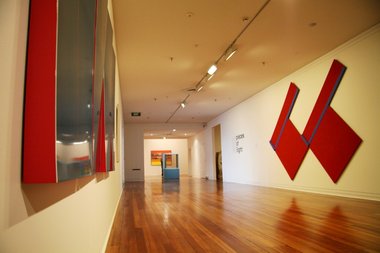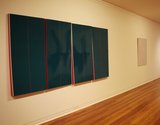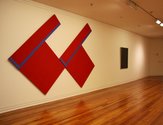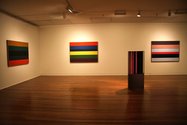John Hurrell – 10 November, 2010
In ‘Eight New Zealand Abstract Painters' Hutchings discussed the works of Gordon Walters, Don Peebles, Melvin Day, Milan Mrkusich, Ralph Hotere, John Drawbridge, Don Driver and Ray Thorburn. For 'Pieces of Eight' Kreisler includes Walters, Peebles, Thorburn, Mrkusich and Hotere. They create a 'chat-room' with the Drivers through the wall. Five of the works come from the Dunedin Public Art Gallery Collection. The other is borrowed from the Govett-Brewster.
Dunedin
Pieces of Eight
Curated By Aaron Kreisler
8 October 2010 - 30 January 2011
Located in the long corridor leading up to a wonderful early seventies ‘geometric’ Don Driver exhibition, of fourteen austere wall ‘paintings’ (of projecting horizontal panels) and four freestanding box-shaped sculptures, Aaron Kreisler has organised a small show (six paintings) that references the bigger exhibition’s context - as well as an important article that P.A.E. Hutchings wrote for Art International in the mid seventies on New Zealand abstraction. New Zealand painting was going through some particularly exciting changes during this period.
In ‘Eight New Zealand Abstract Painters’ Hutchings discussed the works of Gordon Walters, Don Peebles, Melvin Day, Milan Mrkusich, Ralph Hotere, John Drawbridge, Don Driver and Ray Thorburn. For Pieces of Eight Kreisler includes Walters, Peebles, Thorburn, Mrkusich and Hotere (who has two Requiems). They create a sort of ‘chat-room’ with the Drivers through the wall. Five of the works come from the Dunedin Public Art Gallery Collection. The other is borrowed from the Govett-Brewster.
Both Walters and Mrkusich had similar works downstairs in the concurrent Beloved Collection show, but that exhibtion finished at the end of October. In Pieces of Eight we get to see a terrific work from Thorburn, whose practice during that decade with his car-lacquer sprayed Modular series was remarkable, and unusual work from the late Don Peebles.
Thorburn is usually known for his works of four, highly saturated, squared panels that can be put together in any combination of square, or horizontal / vertical line, and which used complex formations of masking tape to create dense perspectival configurations of receding lines.
His work in Pieces of Eight, made while he was a Hodgkins Fellow in 1973, features four highly reflective, green, vertical panels that swell out and are subtly buckled and twisted. They are butted together and their oppositionally hued red sides taper off and have a highlighted white edge. The work changes in its topographical nuances as you work in front of it, passing from one side to the other and seeing its accentuated edges, not only from the white lines but also where the red meets the green.
The double-canvas red Peebles is from four years earlier, and shows ideas with projected form and shadow that anticipate the notions Driver more fully systematically explored in the panelled works next door - explorations that seem to come from the two Donalds: Peebles and Judd.
Peebles examines the retinal effects of advancing blocks of red and retreating receding blue, and mixes them with real projecting space. The red spills downwards along the double diagonally aligned planes, while the blue lines, on the far left of each of the two units, are built up and raised above the red in chunkier bars that, because they are thicker than the extended square planes, cast a shadow. Real space contradicts optical.
In this way Peebles converses with Thornburn and Driver, while the thin coloured lines of Mrkusich’s matt grey panels and Hotere’s well known glossy black ones have their own dialogue, and with the vertical edges of Driver’s glowing Perspex panels. Walters is slightly out on a limb with his tonally contrasting horizontal rhythms and thin ribbon forms instead of korus, but some wall Drivers have a similar vertically descending pulse, but with more lurching and jumpier - less even.
In these two shows, Driver and Thorburn, Peebles, Mrkusich, Hotere and Walters shed light on each other’s working methods. A rare and immensely pleasurable opportunity for some speculative historical analysis.
John Hurrell







 Advertising in this column
Advertising in this column Two Rooms presents a program of residencies and projects
Two Rooms presents a program of residencies and projects



This Discussion has 0 comments.
Comment
Participate
Register to Participate.
Sign in
Sign in to an existing account.